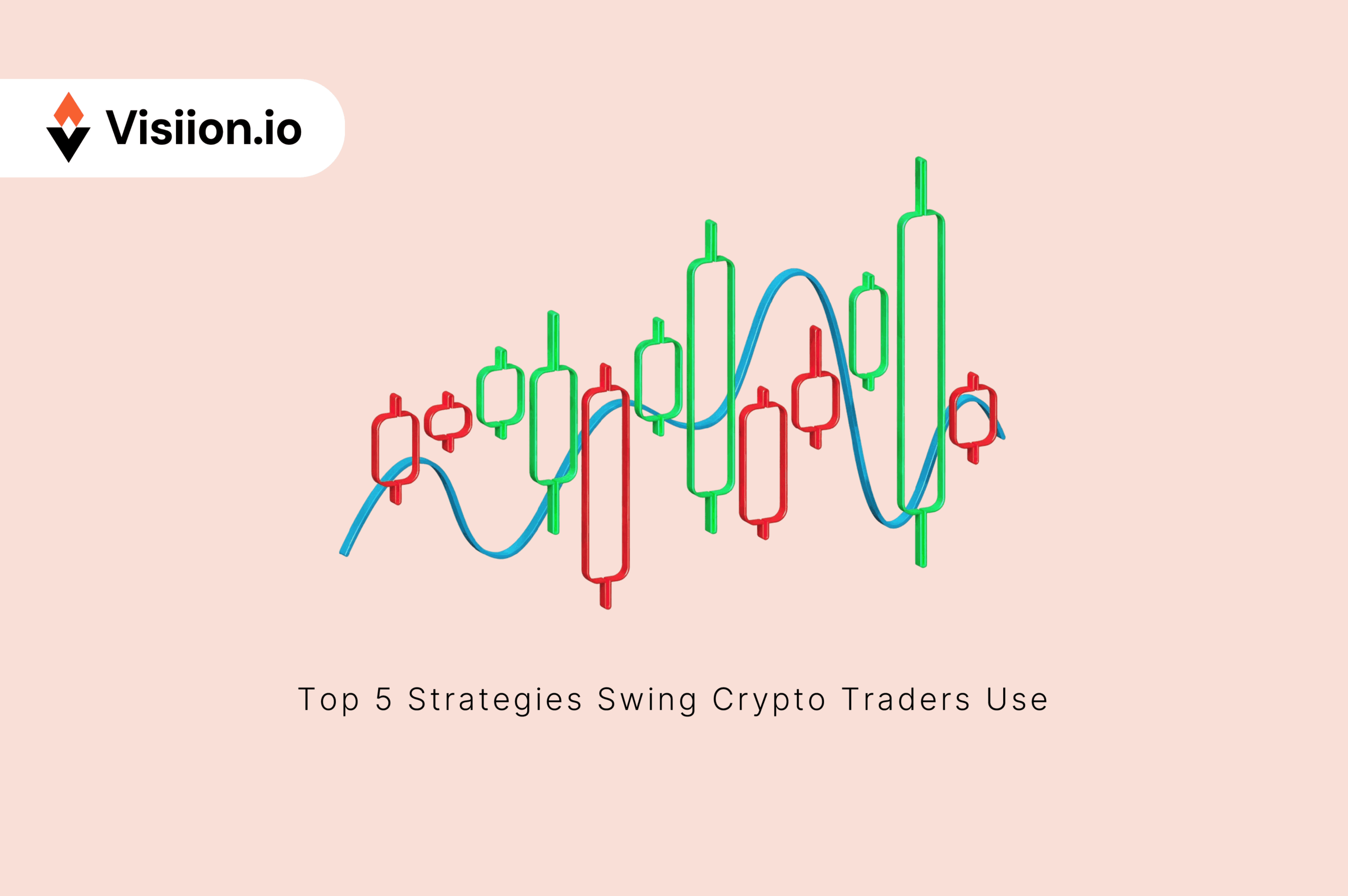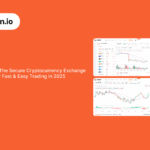Crypto swing trading is a trading approach that captures mid-range moves, typically over days or weeks. Traders who use this method often focus on structure, discipline, and setups that help them manage crypto’s volatility without constantly reacting to every price tick. In this blog, we will take a look at some of the most popular crypto swing trading strategies.
But first, let’s brush up some basics.
What is Swing Trading?
Swing trading is a trading method where traders grab swings in a larger trend. It’s way less frantic than day trading. Generally, the time frame of swing trades is between a couple of days and a couple of weeks. Traders analyze chart trends, support/resistance levels, momentum indicators like RSI or MACD, and classic formations such as channels or breakouts.
Experienced traders generally fuse trend-following techniques with reversal setups and volume confirmation to optimize entries. They focus a lot on liquidity and volatility. They know crypto behaves differently than forex or stocks, its swings come fast.
So they build their trade setups around this fact. Now let’s take a look at the 5 most popular crypto swing trading strategies.
5 Most Popular Swing Trading Strategies
#1: Trend-Following: Breakouts and Pullbacks
Some of the most observed methods in swing crypto trading revolve around joining a move after the trend has already revealed itself.
There are generally two types of entries seen with this mindset:
- Breakouts: When price crosses above a known resistance zone or key trendline, many traders consider that the structure has changed. This break often appears with a rise in volume or momentum indicators.
- Pullbacks: In an existing trend, price occasionally returns to prior support or touches a moving average like the 20-day or 50-day. Some swing traders view that retracement as an opportunity to re-engage with the trend after a minor cooldown.
In both cases, the interest centers around confirmation rather than anticipation. The focus is often on continuation rather than prediction. Tools like ADX or moving average crossovers may show up in these crypto swing trading strategies, along with timeframe overlays to distinguish macro vs short-term swings.
Daily charts are commonly used for trend visibility. Lower timeframes, such as 4H or 6H, frequently support more precise entries. Regardless of method, traders following this approach tend to work with directional momentum instead of going against it.
#2: Support/Resistance and RSI Setups
Another strategy observed among swing traders involves combining horizontal levels with oscillator indicators.
The first thing traders do is to map different key supports and resistance zones based on historic swing highs and lows. Once price moves near one of these areas, some traders start monitoring momentum indicators like RSI or Stochastic.
The RSI, for example, may reflect “oversold” conditions near a long-standing support zone. Or it can be used to identify an “overbought” zone when the price reaches a resistance band. Some traders even go deeper. They look at divergences where prices make new highs or lows, but the RSI does not support that move. They believe such conditions are a result of slowing momentum.
Sometimes, traders pair these setups with candlestick formations like hammers or engulfing patterns. A bullish candle appearing at support while RSI lifts off the 30-line is often seen as potential upward pressure. The inverse plays out around resistance with RSI dropping from elevated levels.
These tools, however, are rarely used in isolation. They’re often part of a confluence approach, where multiple indicators or chart features align.
#3: Fibonacci Retracements and Extensions
Fibonacci-based analysis remains a fixture in swing crypto trading. It’s often observed on charts after significant price movements, either sharp rallies or steep drops.
Some traders draw retracement levels between recent swing highs and lows. The 38.2%, 50%, and 61.8% levels are most frequently highlighted. These areas are not assumed to be guarantees of reversal. Instead, traders view them as points where the price might consolidate or bounce. And this becomes even more prominent when other factors support that idea.
When a Fibonacci level overlaps with a moving average or a previous resistance-turned-support, it’s known as confluence. And this is where traders pay a lot of attention.
Traders sometimes use Fibonacci extensions (e.g., 1.272 or 1.618) to mark possible take-profit zones once a swing position is underway. While these are not hard targets, traders use them as reference points where prices might stall.
Overall, traders use Fibonacci tools for an overall idea and not as specific entry or exit triggers.
#4: Chart Patterns: Boxes, Flags, and Channels
Chart patterns continue to be a regular part of swing trading discussions. Traders believe that although they might not be precise every time, they do offer a view on the asset’s price behavior.
The most common structures that traders follow include:
- Range Boxes
It’s a structure where an asset’s price moves between horizontal support and resistance. Some traders build their setups within these boxes. They take trades near the boundaries, while avoiding the center unless momentum builds.
- Flags and Pennants
These are continuation patterns. These patterns often emerge after strong directional moves. Here, the asset’s price consolidates in a narrow band and creates a flag shape. When price exits that consolidation, it often continues in the same direction as the move that came before it, as per some experts.
- Channels
Ascending or descending channels, bounded by parallel lines, allow swing traders to track mid-trend pullbacks and continuation points. Some use these channels as trading lanes, while others wait for the price to break out.
Traders who follow chart patterns typically monitor duration, volume contraction or expansion, and breakout confirmation. Patterns are rarely used in isolation; they often serve as a visual layer on top of moving averages, RSI, or volume tools.
Pattern watching is less about predicting a shape and more about observing behavior inside key zones.
#5: Momentum and Volume Confirmation
Momentum-based crypto swing trading strategies rely on speed and strength of movement, often tracked using volume spikes, candle body expansion, and high-timeframe structure.
Some swing traders look for periods of compression followed by a burst in volume. The theory here is that a squeeze or tight consolidation zone creates pent-up energy. When price breaks out, volume helps validate whether the move is supported or just noise.
Indicators like MACD, RSI, or VWAP occasionally appear in these setups. But many traders simply monitor raw price action and volume bars to gauge strength.
Institutional buying interest, such as large transaction clusters or exchange inflows, sometimes plays a role in momentum confirmation. Other traders overlay volume profiles to identify which levels see sustained activity and which act as short-term traps.
Momentum without volume often draws skepticism. For that reason, swing traders who use momentum setups usually track not just the initial breakout but also follow-up candles. Price holding its gains, consolidating above the breakout, or building a base tends to be interpreted as strength.
Timing & Timeframes
Swing crypto traders usually operate across multiple chart timeframes:
- Daily chart to identify the main trend
- 4-hour chart to fine-tune entry zones, see pullbacks
- 1‑hour or 30‑minutes to manage intraday swing entries/alerts
They discuss monitoring broader market conditions, like BTC dominance, stablecoin flows, regulatory news, or equity correlation, while deploying these crypto swing trading strategies. These context checks often determine whether a signal is strong or weak.
Some Cautionary Notes from Pro Traders
A lot of experts mention that no strategy wins every time. Indicators can fail. Patterns can break early. Over-optimization leads to curve‑fitting. Therefore seasoned traders repeatedly say, “Our consistent execution and control are extremely important.”
Pro traders often refer to journaling every swing setup, tracking what worked, and reviewing outcomes. Pro traders believe that stick to the strategy rules, accept losses, and don’t chase natural bust-outs unless backed by signal confirmation.
Analysts warn that retail hype can flood setups with noise. Momentum trades may trigger false breakouts during low-volume sources. Trendlines can be subjective. That’s why combining multiple layers, like confirming volume, pattern integrity, and oscillator alignment, can improve conviction.
Variation in Trade Types
Some swing traders mix strategies depending on market conditions:
- In trending markets, they prefer trend following or pullback entries.
- In range-bound markets, they use channel/swing within boxes or support/resistance setups.
- In volatile, news-driven cycles, they rely on momentum spikes with volume filters.
Experts note that flexibility matters.
Why These Crypto Swing Trading Strategies Persist?
Swing trading appeals to traders who can’t monitor screens all day but still seek gains beyond long-term holds. These crypto swing trading strategies give structure:
- Trend trades ride moves without overtrading
- Support/resistance tools help identify entries in sideways conditions
- Fibonacci and chart patterns add precision to entry zones
- Momentum volume filters catch institutional flows early
Pro traders say they constantly refine their edge by overlaying these tools and ignoring setups that lack volume or alignment.
Wrapping Up
Crypto swing trading is a method that helps traders grab opportunities for short term. There is no one single “hack” or “trick” for swing trading. Instead crypto swing traders stick to multiple crypto swing trading strategies, sometimes fuse them to get the accurate result and trade accordingly.
We hope you are now aware of the top crypto swing trading strategies that a lot of successful traders use. Experts suggests that the most important part of any crypto swing trading strategy is patience and practise.
We hope you liked this blog. If you are interested in more such topics, feel free to explore our website. You will find a lot more interesting topics there.
Note: Visiion.io does not endorse or oppose any strategy or crypto mentioned in the blog above. Consult with your financial advisor before putting your money in Crypto market.









